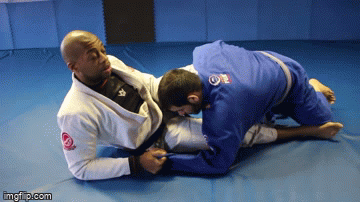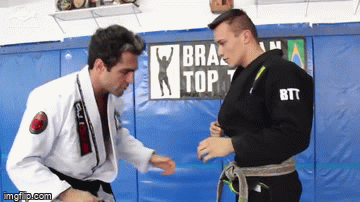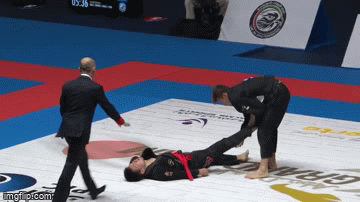
The loop choke could just be the sneakiest choke in all of Jiu-Jitsu. Well, not all of it, since you can’t really pull it off without a Gi. However, when a Gi is in the game, you can pretty much hit a loop choke from anywhere. I love using it in combination with guillotine chokes in order to be able to move an opponent from top or bottom into positions I like. In fact, the loop choke shares many similarities with the guillotine choke. One such example is that you can do a standing loop choke to finish opponents quickly and in a devastating fashion. And it may just be even more effective than standing guillotines.
IN BJJ, we don’t see that many standing submissions. It is understandable, as people do tend to go to the ground if they notice someone is setting up a standing submission. That’s a legitimate strategy, as it’ll most likely get you out of the submission. I guess this is why most grapplers tend to overlook standing submissions. In their defense, most of the standing stuff doesn’t work anyway. However, there are those that work, and the standing loop choke is at the top of the pile.
Getting Familiar With The Loop Choke
The standing loop choke is a bit different than the one done on the ground, but it shares the same principles. Conversely, all the little tip s and trick for a regular loop choke apply, so we’ll take a look at the basic version before we take things to the feet.
The loop choke is basically a guillotine choke done with a grip on the opponent’s collar, rather than any guillotine grip variation. You can look at it as a cheat choke when it comes to attacking a guillotine with the Gi. Many times the guillotine won’t work because the Gi is in the way of the grip. Well, instead of moaning about it, if you decide to use Gi that is “in the way” you’ll get one of the easiest chokes in Jiu-Jitsu.

The first loop choke “hack” you need to know is that you shouldn’t place the head deep inside your armpit. Only the crown of the opponent’s head should touch your armpit. This makes it impossible for them to use neck strength, or pop their head, out due to the configuration of the choke.
For the finish itself, you place your free arm with the forearm across the back of the opponent’s neck. This is where I’ll share another major game-changing detail – don’t go deep. There’s no need to try and thread your arm deep into your armpit. Having your palm inside your elbow is more than enough to finish the choke. In fact, it makes the choke even tighter, as opposed to having someone’s head deep in your armpit, and the free arm deep inside your own elbow crease.
A Submission From Hell – Standing Loop Choke
Now that basic mechanics and a couple of subtle tricks are out of the way, let’s focus on the standing loop choke. Alexandre Vieira, a Brazilian Jiu-Jitsu black belt under Murilo Bustamante popularized and refined the sanding loop choke back in his brown belt days. He even has several different variations of the standing loop choke and has executed them against some of the world’s best grapplers.


Loop Choke Defense?
Escape early or escape late. That’s the mantra of escapes that you should follow if you want to successfully wiggle out of stuff in BJJ. In the case of the loop choke, there aren’t many late defenses, especially if the person is doing a standing loop choke which tends to get tighter and tighter with every step. Early defenses, however, work and will frustrate a loop choke hunter, at least for a while.
The earliest thing you can do and should be doing anyway is focusing on posture. Many times when people focus on grip breaks they forget about the rest of their body, including their posture. Grips are the perfect way to take your attention to other things, and you should wise up to it. It is way more important to keep a good posture than it is to break the grip. Remember, if people can’t snap you down, they won’t’ be able to get either a guillotine ora loop choke.
That said, in certain situations, you’ll find yourself in the loop. The one thing that makes the choke practical and quick is also a flaw to an extent. If you can time it right, you can actually use the fact that they’re gripping your collar against them. Namely, instead of trying to fight the grip outright, when you’re in the loop, simply undo your Gi from your belt, This will allow the collar to slide across your neck, and the opponent’s grip will actually pull the Gi creating space, rather than choking you. Sneaky, but it can work if you time it right.
Final Words
Standing submissions are extremely fun and feel like a million buck when you hit them in competition. Apart from some wrist locking options, though I’d say the standing loop choke is your best bet of hitting a standing submission. Granted, you’ll end up on the ground more times than not, but it still counts as a standing submission if you set it up from the feet. Plus, you can always use the loo0p choke position to set up a host of takedowns, from the Kata Guruma toa simpler ankle picks, that you can still turn into loop choke finishes. So many possibilities….


![Darce Choke Encyclopedia – Origins, Mechanics and Variations [2025] BJJ, choke, Brabo, BJJ Darce Choke, D'arce Choke, Darce BJJ Choke](https://bjj-world.com/wp-content/uploads/2017/11/JungPoirierLeeYahoo-218x150.jpg)










![Get Off My Legs Gringo Craig Jones DVD Review [2025] Get Off My Legs Gringo Craig Jones DVD Review](https://bjj-world.com/wp-content/uploads/2025/03/get-off-my-legs-gringo-craig-jones-dvd-review-218x150.png)

![Leg Lock Entries Helena Crevar DVD Review [2025] Leg Lock Entries Helena Crevar DVD Review](https://bjj-world.com/wp-content/uploads/2025/03/leg-lock-entries-helena-crevar-dvd-review-218x150.png)
![Special K Guard Neil Melanson DVD Review [2025] Special K Guard Neil Melanson DVD Review](https://bjj-world.com/wp-content/uploads/2025/03/special-k-guard-neil-melanson-dvd-review-218x150.png)
![Arm Bar It All Shawn Melanson DVD Review [2025] Arm Bar It All Shawn Melanson DVD Review](https://bjj-world.com/wp-content/uploads/2025/03/arm-bar-it-all-shawn-melanson-dvd-review-218x150.png)
![Jett Thompson Master Ankle and Aoki Lock DVD Review [2024] Jett Thompson Master Ankle and Aoki Lock DVD Review](https://bjj-world.com/wp-content/uploads/2024/09/jett-thompson-master-ankle-and-aoki-lock-dvd-review-324x235.png)
![I Got Your Back Jake Straus DVD Review [2025] I Got Your Back Jake Straus DVD Review](https://bjj-world.com/wp-content/uploads/2025/03/i-got-your-back-jake-straus-dvd-review-100x70.png)

![Slip N Slide Into Victory Julián Espinosa DVD Review [2025] Slip N Slide Into Victory Julián Espinosa DVD Review](https://bjj-world.com/wp-content/uploads/2025/01/slip-n-slide-into-victory-julian-espinosa-dvd-review-100x70.png)

![Henry Akins Black Hole No-Gi Closed Guard DVD Review [2024] Henry Akins Black Hole No-Gi Closed Guard DVD Review](https://bjj-world.com/wp-content/uploads/2024/09/henry-akins-black-hole-no-gi-closed-guard-dvd-review-100x70.png)
![Master The Move The American Lock John Danaher DVD Review [2024] Master The Move The American Lock John Danaher DVD Review](https://bjj-world.com/wp-content/uploads/2024/12/the-american-lock-john-danaher-dvd-review-100x70.png)

![Reverse Armlock Magid Hage DVD Review [2024] Reverse Armlock Magid Hage DVD Review](https://bjj-world.com/wp-content/uploads/2024/12/reverse-armlock-magid-hage-dvd-review-100x70.png)



![Front Head Lock Kaynan Duarte DVD Review [2025] Front Head Lock Kaynan Duarte DVD Review](https://bjj-world.com/wp-content/uploads/2025/02/front-head-lock-kaynan-duarte-dvd-review-100x70.png)



![Mastering Takedown Prevention Steve Mocco DVD Review [2024] Mastering Takedown Prevention Steve Mocco DVD Review](https://bjj-world.com/wp-content/uploads/2024/11/mastering-takedown-prevention-steve-mocco-dvd-review-100x70.png)

![Complete Fundamentals Curriculum Eliot Marshall DVD Review [2025] Complete Fundamentals Curriculum Eliot Marshall DVD Review](https://bjj-world.com/wp-content/uploads/2025/02/fundamentals-curriculum-eliot-marshall-dvd-review-100x70.png)

![Intro To Hip Mobility for Guard Players Joshua Presley DVD Review [2024] Intro To Hip Mobility for Guard Players Joshua Presley DVD Review](https://bjj-world.com/wp-content/uploads/2024/09/hip-mobility-for-guard-joshua-presley-dvd-review-100x70.png)
![Simplify the System Side Scissor Brian Glick DVD Review [2024] Simplify the System Side Scissor Brian Glick DVD Review](https://bjj-world.com/wp-content/uploads/2024/09/side-scissor-brian-glick-dvd-review-2024-100x70.png)
![Zen Guide To Submission Grappling Margot Ciccarelli DVD Review [2025] Zen Guide To Submission Grappling Margot Ciccarelli DVD Review](https://bjj-world.com/wp-content/uploads/2025/02/submission-grappling-margot-ciccarelli-dvd-preview-100x70.png)
![Advantage Over Time Outside Passing Jozef Chen DVD Review [2025] Advantage Over Time Outside Passing Jozef Chen DVD Review](https://bjj-world.com/wp-content/uploads/2025/03/outside-passing-jozef-chen-dvd-review-100x70.png)


![Giancarlo Bodoni DVD Bundle Essential Connections Full Review [2024] Giancarlo Bodoni DVD Bundle Essential Connections Full Review](https://bjj-world.com/wp-content/uploads/2024/09/giancarlo-bodoni-dvd-bundle-essential-connections-100x70.png)
![Leg Lock Stock And Barrel Taylor Pearman DVD Review [2025] Leg Lock Stock And Barrel Taylor Pearman DVD Review](https://bjj-world.com/wp-content/uploads/2025/03/leg-lock-stock-and-barrel-taylor-pearman-dvd-review-100x70.png)
